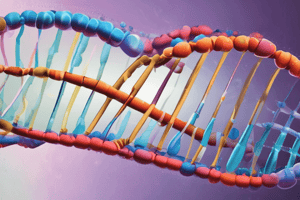Podcast
Questions and Answers
The process by which a cell copies its DNA before cell division is called ______.
The process by which a cell copies its DNA before cell division is called ______.
DNA replication
The enzyme responsible for unwinding the double helix during DNA replication is ______.
The enzyme responsible for unwinding the double helix during DNA replication is ______.
helicase
During protein synthesis, the process of converting mRNA into a protein is known as ______.
During protein synthesis, the process of converting mRNA into a protein is known as ______.
translation
In protein synthesis, the molecule that carries amino acids to the ribosome is called ______.
In protein synthesis, the molecule that carries amino acids to the ribosome is called ______.
The phase of DNA replication where the leading strand is synthesized continuously and the lagging strand is made in short segments is called ______.
The phase of DNA replication where the leading strand is synthesized continuously and the lagging strand is made in short segments is called ______.
Flashcards are hidden until you start studying
Study Notes
Molecular Biology Study Notes
DNA Replication
- Definition: The process by which a cell copies its DNA before cell division.
- Key Enzymes:
- Helicase: Unwinds the double helix.
- DNA Polymerase: Synthesizes new DNA strands by adding nucleotides.
- Ligase: Joins Okazaki fragments on the lagging strand.
- Phases of DNA Replication:
- Initiation:
- Begins at origins of replication.
- Formation of replication forks.
- Elongation:
- Leading strand synthesized continuously.
- Lagging strand synthesized in short segments (Okazaki fragments).
- Termination:
- Completion of DNA strands.
- Verification of fidelity through proofreading by DNA polymerase.
- Initiation:
- Mechanism:
- Semi-conservative model: Each new DNA molecule contains one original and one daughter strand.
Protein Synthesis
- Overview: The process of translating genetic information from DNA into proteins.
- Key Processes:
- Transcription:
- Occurs in the nucleus.
- DNA is transcribed into messenger RNA (mRNA).
- RNA polymerase adds complementary RNA nucleotides.
- mRNA undergoes splicing to remove introns.
- Translation:
- Occurs in the cytoplasm at ribosomes.
- mRNA is read in codons (sets of three nucleotides).
- Transfer RNA (tRNA) brings amino acids to the ribosome.
- Ribosome facilitates the formation of peptide bonds between amino acids.
- Transcription:
- Key Molecules:
- mRNA: Carries the genetic code from DNA.
- tRNA: Adaptor molecule that translates mRNA codons into amino acids.
- Ribosomes: Molecular machines that synthesize proteins.
- Post-Translational Modifications:
- Proteins often undergo modifications such as phosphorylation, glycosylation, and cleavage before becoming fully functional.
DNA Replication
- The process of copying DNA before cell division
- Key Enzymes:
- Helicase: Unwinds the DNA double helix
- DNA Polymerase: Builds new DNA strands by adding nucleotides
- Ligase: Connects Okazaki fragments on the lagging strand
- Phases:
- Initiation: Starts at origins of replication, forming replication forks
- Elongation: Leading strand is synthesized continuously, while the lagging strand is made in short segments (Okazaki fragments)
- Termination: DNA strands are completed and proofread by DNA polymerase for accuracy
- Mechanism:
- Semi-conservative model: Each new DNA molecule has one original and one newly synthesized strand
Protein Synthesis
- The process of turning genetic information from DNA into proteins
- Key Processes:
- Transcription: Happens in the nucleus. DNA is transcribed into messenger RNA (mRNA). RNA polymerase adds RNA nucleotides complementary to DNA. mRNA undergoes splicing to remove non-coding regions (introns).
- Translation: Happens in the cytoplasm at ribosomes. mRNA is read in groups of three nucleotides called codons. Transfer RNA (tRNA) carries specific amino acids to the ribosome, matching them to the mRNA codons. The ribosome helps form peptide bonds between these amino acids, building a protein chain.
- Key Molecules:
- mRNA: Carries genetic code from DNA
- tRNA: Adaptor molecule that converts mRNA codons into amino acids
- Ribosomes: Molecular machines that assemble proteins
- Post-Translational Modifications:
- Proteins often undergo changes like phosphorylation, glycosylation, and cleavage to become fully functional.
Studying That Suits You
Use AI to generate personalized quizzes and flashcards to suit your learning preferences.




